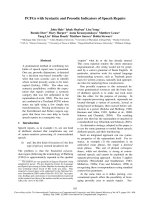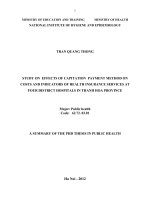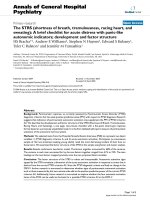macroeconomic indicators
Bạn đang xem bản rút gọn của tài liệu. Xem và tải ngay bản đầy đủ của tài liệu tại đây (4.04 MB, 19 trang )
<span class="text_page_counter">Trang 1</span><div class="page_container" data-page="1">
Instructor: Tô Thị Thùy DươngClass: IB1808
Semester: Summer 2023Student’s Name and ID:
1. Phạm Kiều Đức Trí __________________________SS1809882. Nguyễn Hồng Minh Thư_____________________SS1810513. Lê Q Dương______________________________SS1812964. Tăng Thị Minh Châu_________________________SS1813165. Lê Anh Quân_______________________________SE1730476. Nguyễn Thị Thanh Phụng_____________________SS1707867. Trắc Tường Hi______________________________SS180979
1
</div><span class="text_page_counter">Trang 2</span><div class="page_container" data-page="2">Table of Contents
I. INTRODUCTION...3
II. MACROECONOMIC INDICATORS...3
1. National Income and Growth...3
1.1. Gross Domestic Product (GDP)...3
1.2. Gross Domestic Product by industries...5
2. Cost of Living...7
2.1. Consumer Price Index...7
3. Inflation...8
4. Unemployment Rate...9
III. SAVING, INVESTMENT, AND BUSINESS CYCLES...11
1. Saving and Investment...11
</div><span class="text_page_counter">Trang 3</span><div class="page_container" data-page="3">I. INTRODUCTION
Over the past decade, Japan has been navigating a complex economic landscape of variouschallenges and opportunities. The country, known for its technological advancements, export-oriented industries, and commitment to innovation, has faced a range of factors that have shaped itseconomic performance. Japan has been striving to achieve sustainable economic growth, addressstructural challenges, and manage macroeconomic factors such as inflation, employment, and tradeopenness. The government has implemented policies and initiatives to stimulate the economy,promote investment, and enhance the overall competitiveness of Japanese industries.
Amidst a rapidly changing global landscape, Japan has also been focusing on expanding itstrade relations and enhancing its position in the global market. By actively participating in regionaltrade agreements and fostering international collaborations, Japan aims to boost its exports andpromote economic interdependence with other countries.
Japan continues to chart its path toward sustained economic growth, resilience, and globalcompetitiveness in this dynamic economic landscape. By leveraging its strengths, adapting toemerging trends, and implementing strategic policies, Japan aims to navigate the challenges of thepast decade and position itself for a prosperous and resilient future.
II. MACROECONOMIC INDICATORS1. National Income and Growth
1.1. Gross Domestic Product (GDP)
[ CITATION Sta22 \l 1033 ]
Figure 1: Economic Growth Rate
3
</div><span class="text_page_counter">Trang 4</span><div class="page_container" data-page="4">(Source: Statistical Handbook of Japan 2022, Statistics Bureau, Ministry of Internal Affairsand Communications, Japan.)The economic growth trend in Japan has been marked by various phases and fluctuationsover the past decade. From 2008 to 2020, Japan experienced a mix of growth, periods ofcontraction, and moderate expansion. In the aftermath of the global financial crisis in 2008, Japan'seconomy faced significant challenges. The country's GDP contracted in 2009, reflecting the impactof the global economic downturn. However, Japan's economy rebounded in subsequent years,registering growth from 2010 to 2012.
In 2011, Japan faced a major setback in the form of the Great East Japan Earthquake andsubsequent tsunami, which resulted in extensive damage and loss of life. The natural disaster had asignificant impact on the economy, leading to disruptions in production, supply chains, and energyresources. The immediate aftermath of the disaster resulted in a contraction in GDP. However, from2012 to 2013, Japan's economy saw a period of accelerated growth due to the implementation of"Abenomics" policies.
Figure 2: Economics Growth Rate
(Source: Statistical Handbook of Japan 2022, Statistics Bureau, Ministry of Internal Affairsand Communications, Japan.)Amidst these initiatives, the Japanese economy has continued to show signs of moderate recovery, with profits of companies at high levels. However, due to factors like the slowdown in theChinese economy, and a lull in global demand for information-related goods, weakness has been evident in some areas of export and production since the second half of 2018. On the other hand, theincreasing trend in domestic demand has been maintained, supported by factors like improvement inthe employment and income environment, and high company profits.
Furthermore, the COVID-19 pandemic, which emerged in 2020, had a significant impact onJapan's economy. The pandemic resulted in disruptions to global trade, restrictions on mobility, and
4
</div><span class="text_page_counter">Trang 5</span><div class="page_container" data-page="5">a decline in consumer spending. These factors contributed to a contraction in GDP in 2020, as thecountry faced challenges in containing the spread of the virus and managing its economicconsequences. However, Japan implemented various measures to support businesses, provideincome support, and promote economic recovery.
1.2. Gross Domestic Product by industries
Figure 3: Gross Domestic Product by Type of Economic Activity
(Source: Statistical Handbook of Japan 2022, Statistics Bureau, Ministry of Internal Affairs andCommunications, Japan) The manufacturing industry plays a vital role in contributing to Japan's GDP. In 2019,manufacturing sector made a significant contribution, accounting for 20,3% of total GDP. Thisindustry represents the most value-adding sector in the Japanese economy. The country'smanufacturing process has enabled it to gain a competitive edge in global markets. The automotiveindustry, for example, boasts globally recognized Japanese brands such as Toyota, Honda, andNissan.
In years past, Japan's manufacturing industry has faced a variety of unforeseeablecircumstances and drastic changes in the business environment. These include the bankruptcy of themajor American securities firm Lehman Brothers, the European debt crisis, and the Great EastJapan Earthquake in the 21st century. Each time that Japan's manufacturing industry has faced thesekinds of unforeseeable circumstances and drastic changes in the business environment, it has been
5
</div><span class="text_page_counter">Trang 6</span><div class="page_container" data-page="6">able to overcome them and evolve. However, to overcome the recent crisis caused by COVID-19will require even more substantial reforms than before.
Figure 4: Establishments, Persons Engaged, and Value of Manufactured Goods Shipments ofthe Manufacturing Industry
(Source: Japan’s Ministry of Economy, Trade and Industry) In 2019, there were 185,116 establishments (with 4 or more persons engaged) in themanufacturing sector. By industry, "fabricated metal products" had the most, with 25,213establishments (component ratio of 13.6 percent), followed by "food" with 24,440 establishments(13.2 percent) and "production machinery" with 18,446 establishments (10.0 percent), haveproduced cutting-edge technology, influencing sectors worldwide.
To maintain economic stability and promote growth, the Japanese government closelymonitors GDP trends and employs fiscal and monetary policies accordingly. The Bank of Japan, the
6
</div><span class="text_page_counter">Trang 7</span><div class="page_container" data-page="7">nation's central bank, plays a pivotal role in implementing monetary policies to influence interestrates, manage inflation, and ensure financial stability, indirectly impacting GDP growth.
Looking ahead, Japan continues to focus on strategies for sustainable economic growth.Efforts to address structural challenges, such as an aging population and low productivity, remaincrucial. The government is also prioritizing initiatives to promote innovation, technology adoption,and sustainability to drive future growth.
In conclusion, the economic growth trend in Japan has seen a mix of expansion, contraction,and recovery over the past decade. The country has faced challenges such as the global financialcrisis, natural disasters, and the ongoing impact of the COVID-19 pandemic. However, throughpolicy interventions and resilience, Japan has demonstrated its ability to rebound and pursuestrategies for sustainable growth. Continued focus on addressing structural challenges and fosteringinnovation will be key in shaping Japan's economic growth in the coming years.
2. Cost of Living
2.1. Consumer Price Index
The all-items index of consumer prices (with base year 2015 = 100) was 101.8 in 2020, the same level as the previous year. There are two factors behind stable CPI of Japan, the first involves certain state controls that can limit price rises. Gas and electricity regulations dictate that price hikescan only happen gradually. This means utility companies tend to secure long-term supply contracts, which in turn stabilizes energy costs. The situation with wheat is similar. Japan imports most of its wheat through a government organization that fixes resale prices for six months at a time. This has helped the country avoid the worst impacts of rising wheat prices and maintain low inflation.
Figure 5: CPI for major categories
(Source: Statistics Bureau, MIC of Japan)The cost of living in Japan is known to be relatively high, particularly in urban areas such asTokyo and Osaka. Housing expenses form a significant portion of the overall cost of living. Rentalprices and property prices can be quite steep, especially in major cities like Tokyo. Limited living
7
</div><span class="text_page_counter">Trang 8</span><div class="page_container" data-page="8">space and strict building regulations contribute to the high prices. Renting an apartment oftenrequires a substantial initial deposit and additional expenses like key money and agency fees.
Food costs in Japan can also be relatively high. While the country offers a wide range ofculinary options, dining out at restaurants can be costly, especially in upscale establishments.
Transportation fees can significantly impact the cost of living, especially for individualscommuting regularly or traveling between cities. Japan has an extensive and efficient transportationsystem, but public transportation can be expensive, particularly for long-distance travel.
Other goods and services also contribute to the cost of living in Japan. Utilities likeelectricity, water, and gas tend to be relatively expensive. Internet and mobile phone plans maycome at a higher cost compared to other countries. Healthcare expenses can be significant, althoughJapan's universal healthcare system provides access to high-quality medical services. Expensesrelated to education, entertainment, and leisure activities can vary depending on personalpreferences and lifestyle choices.
3. Inflation
Figure 6: Japan’s Price Trends
(Source: Bank of Japan)Since 2010, the trend was generally downwards, but it turned upward starting in the thirdquarter of 2013 due to weakening of the yen. As a result of the increase in the consumption tax from5 percent to 8 percent in April 2014, the size of the increase grew, but by the second quarter of2015, the stimulative effects of the tax increase subsided. Since the fourth quarter of 2016, anupward trend has continued, due to global resource prices (such as crude oil) and exchange rates,but since 2018, trade friction between the U.S.A. and China has diminished the effect of risingresource prices and increasing food prices have become a greater factor. The consumption tax ratewas raised to 10 percent in October 2019, but the increase in consumer prices was less than 1percent.
In the case of Japan, the country has experienced a prolonged period of low inflation and, attimes, even faced deflationary pressures. In 2 years, 2016 and 2021, this country has faceddeflation; the inflation rate is at -0.1% to -0.3%.
For much of the past decades, Japan has grappled with a condition known as "low inflation"or "persistent deflation." This has been a unique challenge for the country, as it creates an
8
</div><span class="text_page_counter">Trang 9</span><div class="page_container" data-page="9">environment where prices decline or remain stagnant for an extended period. The deflationarypressure has been driven by a combination of factors, including weak consumer spending, subdueddemand, and a persistent gap between supply and demand. The deflationary environment in Japanhas had several consequences. On the one hand, it can appear beneficial for consumers as prices ofgoods and services decline. However, it also leads to decreased corporate revenues and profits,discourages investments, and hampers economic growth. Deflation can create a vicious cycle ofreduced spending and investment, further exacerbating the economic downturn.
The Japanese government and the Bank of Japan (BOJ) have implemented various measuresto combat deflation and stimulate economic growth. One such measure is the BOJ's monetarypolicy, which has included maintaining extremely low-interest rates and engaging in aggressivequantitative easing. These policies aimed to inject liquidity into the economy, encourage borrowingand investment, and stimulate inflation. In recent years, Japan has seen a gradual inflation rise,albeit below the target of 2% set by the BOJ. Factors contributing to this trend include increasedgovernment spending, a tight labor market, and rising commodity prices. Additionally, the BOJ'spersistent efforts to overcome deflation have started to come up with good signs, the inflationinching upward.
In conclusion, Japan's experience with inflation has been characterized by a prolongedperiod of low inflation and, at times, deflationary pressures. The government and the BOJ haveimplemented various measures to combat deflation and stimulate economic growth. While inflationhas started to rise gradually, it remains below the BOJ's target. Achieving stable inflation is crucialfor promoting sustainable economic growth and ensuring a stable business environment in Japan.
4. Unemployment Rate
The employment rate of Japan in 2012 was over 4%, which continued to decrease steadilyover the past decade and get over 2.5% in 2020.
Figure 7: Unemployment Rate and Active Job Openings-to-Applicants Ratio
(Source: Statistics Bureau, MIC; Ministry of Health, Labor and Welfare of Japan)9
</div><span class="text_page_counter">Trang 10</span><div class="page_container" data-page="10">In Japan, various factors have influenced employment dynamics, including demographicchanges, labor market reforms, and government policies. Japan has traditionally boasted a strongemployment record, with a high emphasis on job security and stability. However, the country hasfaced challenges recently due to a rapidly aging population and shifting demographic trends. Thedeclining birth rate and increasing life expectancy have resulted in a shrinking working-agepopulation, posing challenges for sustaining employment rates.
Figure 8: Unemployment Rate by Countries
(Source: Statistical Handbook of Japan 2022, Statistics Bureau, Ministry of Internal Affairs andCommunications, Japan)The Japanese government has implemented policies to support job creation and ensure astable labor market. These efforts include promoting vocational training, enhancing job-matchingservices, and encouraging entrepreneurship. However, underemployment and job marketmismatches have been persistent issues in Japan. The country has witnessed a rise in non-regular orpart-time employment, which often offers less job security and limited access to benefits comparedto regular full-time positions. Addressing these disparities and improving the quality of employmentopportunities have become focal points for policymakers. Therefore, Japan’s unemployment rate islower compared to other countries.
The COVID-19 pandemic significantly impacted employment in Japan, as it did globally.The country experienced a temporary rise in unemployment rates due to business closures andreduced economic activity. However, the government swiftly implemented measures to supportbusinesses, protect jobs, and provide income support to affected individuals and households.
10
</div>








